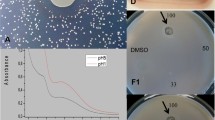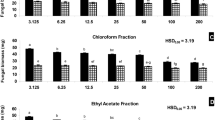Abstract
THE staling of fungal cultures is a topic which has not received much attention recently. Pratt1 described two types of staling agent, organic acids and potassium bicarbonate. She suggested that staling due to the formation of bicarbonate by the carbon dioxide of respiration is of primary importance and occurs whenever the medium is such that a basic radical is set free. She determined that the organic acid radicals were not effective as staling agents in the alkaline-staled medium. Pratt investigated the staling of a species of Fusarium in Richards's solution and her criterion of staleness was based on the average germ-tube length of conidia of Botrytis cinerea sown in drops of the filtered medium in which the Fusarium had grown. More recently Park2 has investigated staling in F. oxysporum using agar cultures of Aspergillus niger as the test organism. Drops of culture medium were pipetted on to the margin of colonies of A. niger and the criterion of staleness was the cessation of extension-growth of the marginal hyphæ with accompanying vacuolation. Vacuolation has since been adopted as the best indication of ageing, since, whereas the stale culture fluid would always induce vacuolation, extension-growth was not permanently inhibited under all conditions of test. It is also important to note that a wide range of substances will cause hyphæ to branch or to cease extension-growth, but no substance among several tried has yet been found to reproduce the vacuolation effect caused by the stale medium from which the bulk of the mycelium has been removed by filtration through nylon gauze. It is of additional interest that both extracts of soil and of pond-water can also induce vacuolation of our test organism. The substance or substances responsible may therefore be associated with microbial habitats of different sorts.
This is a preview of subscription content, access via your institution
Access options
Subscribe to this journal
Receive 51 print issues and online access
$199.00 per year
only $3.90 per issue
Buy this article
- Purchase on Springer Link
- Instant access to full article PDF
Prices may be subject to local taxes which are calculated during checkout
Similar content being viewed by others
References
Pratt, C. A., Ann. Bot., N.S., 38, 563, 599 (1924).
Park, D., Trans. Brit. Mycol. Soc., 47 (in the press).
Author information
Authors and Affiliations
Rights and permissions
About this article
Cite this article
PARK, D., ROBINSON, P. Isolation and Bioassay of a Fungal Morphogen. Nature 203, 988–989 (1964). https://doi.org/10.1038/203988a0
Published:
Issue Date:
DOI: https://doi.org/10.1038/203988a0
This article is cited by
-
Fungicolous Fusarium Species: Ecology, Diversity, Isolation, and Identification
Current Microbiology (2021)
-
The social network: deciphering fungal language
Nature Reviews Microbiology (2011)
-
Bikaverin production and applications
Applied Microbiology and Biotechnology (2010)
-
Changes in the shape and size of vacuoles during autolysis of Neurospora crassa
Mycopathologia (1982)
-
The production of sporostatic factors in soil
Plant and Soil (1972)
Comments
By submitting a comment you agree to abide by our Terms and Community Guidelines. If you find something abusive or that does not comply with our terms or guidelines please flag it as inappropriate.



